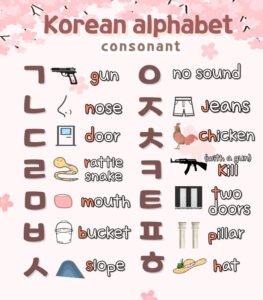Everything about Korean numbers
Hello everyone! In today’s post, we will delve into Korean numbers and related expressions, such as dates, days, and time. Understanding Korean numbers is fundamental for anyone learning the language, as they are used in various daily contexts.
By the end of this post, you’ll have a comprehensive understanding of how to use numbers confidently in Korean.
Let’s get started!
Part 1,
Let’s grasp the concept of grammar
The Two Number System: Korean employs two distinct number systems: Sino-Korean and Native Korean.
Sino-Korean Numbers
The Sino-Korean system is derived from Chinese characters. This system is primarily used for telling time (minutes and seconds), dates and years, counting money, phone numbers and addresses, academic scores and other measurements.
Native Korean Numbers
The Native Korean system, on the other hand, originates from the Korean language itself. It is typically used for telling hour, counting objects, people, and ages.
Sino-numbers : used for dates, money, addresses, phone numbers, and when counting numbers over 40.
Sino-Korean Numbers
Here are the Sino-Korean numbers up to 10:
0: 영 / 공
1: 일
2: 이
3: 삼
4: 사
5: 오
6: 육
7: 칠
8: 팔
9: 구
10: 십
The Korean number structure is very logical and involves simple math, making it straightforward to count numbers.
If you memorize the numbers up to 10, you can easily construct numbers up to 99.
For example) Number 11 = 10 + 1, right? So simply we will say 10 (십) and 1 (일): 11(십일)
11 = 10(십) + 1(일) = 십일
This principle applies to all numbers up to 19:
12 = 10(십) + 2(이) = 십이
13 = 10(십) + 3(삼) = 십삼
14 = 10(십) + 4(사) = 십사
15 = 10(십) + 5(오) = 십오
16 = 10(십) + 6(육) = 십육
17 = 10(십) + 7(칠) = 십칠
18 = 10(십) + 8(팔) = 십팔
19 = 10(십) + 9(구) = 십구
To construct the number 20, we multiply 2 (이) by 10 (십)!
20 = 2(이) * 10(십) = 이십
Similarly, other tens are formed as follows:
30 = 3(삼) * 10(십) = 삼십
40 = 4(사) * 10(십) = 사십
50 = 5(오) * 10(십) = 오십
60 = 6(육) * 10(십) = 육십
70 = 7(칠) * 10(십) = 칠십
80 = 8(팔) * 10(십) = 팔십
90 = 9(구) * 10(십) = 구십
Then, how would it be 57?!
57 = 5*10 + 7
5(오) * 10(십) + 7(칠) = 오십칠
How about 23?!
23 = 2 * 10 + 3
2(이) * 10(십) + 3(삼) = 이십삼
Let’s try these numbers:
1. 38
2. 41
3. 19
4. 52
5. 76
The answer:
1. 삼십팔 (3*10 + 8)
2. 사십일 (4*10 + 1)
3. 십구 (10 + 9)
4. 오십이 (5*10 + 2)
5. 칠십육 (7*10 + 6)
The number 100 in Sino-Korean is 백!
100 = 백
How about 200?
There are 2 hundreds, right? So, we multiply 2 by 100. 2 (이) * 100 (백) = 이백
200 = 이백
We can easily assume the rest!
300 = 3*100 = 삼백
400 = 사백
500 = 오백
600 = 육백
700 = 칠백
800 = 팔백
900 = 구백
The number 1000 in Sino-Korean is: 천
1000 = 천
The same logic! What would be 2000?!
2000 = 2*1000 = 이천
3000 = 삼천
4000 = 사천
5000 = 오천
6000 = 육천
7000 = 칠천
8000 = 팔천
9000 = 구천
Easy, right?
Try to guess these numbers!
1. 1500
2. 4320
3. 8900
4. 7640
5. 2024
The answer:
1. 천오백 ( 1000 + 5 * 100 )
2. 사천삼백이십 ( 4 * 1000 + 3 * 100 + 2 * 10 )
3. 팔천구백 ( 8* 1000 + 9*100 )
4. 칠천육백사십 ( 7*1000 + 6*100 + 4*10)
5. 이천이십사 ( 2*1000 + 2*10 + 4)
Good job! Almost there, finally we will learn the last number : 10,000
You are probably thinking of saying 10 * 1000, but in Korean, we use a different unit for 10,000, which is 만!
10,000 = 만
So, 20,000 is not expressed as “twenty thousand” but rather as “two ten-thousands”: 이만 ( 2 * 10,000)
30,000 = 삼만
50,000 = 오만
How about 100,000 ?!
It’s 10 * 10,000. So it will be 십(10) 만(10,000). 십만.
To say “170,000”, it’s 17 * 10,000 , so it will be 십칠(17) * 만(10,000), 십칠만
To say “1,000,000”, it’s 100 * 10,000, so it’s 백(100) * 만(10,000), 백만
These numbers are commonly used in monetary contexts because our currency amounts are typically quite large.
For example, 1 dollar is around 1,300 won.
Therefore, 100 dollars is approximately 130,000 won, which is written as 십삼만원(won).
1000 dollars is approximately 1,300,000 won, which is 백삼십만 won.
The best way to become familiar with these numbers is through practice! Let’s create more examples in Korean.
Let’s practice writing these numbers on our own.
1. 150,000
2. 38,000
3. 472,000
4. 16,800
5. 956,310
Here’s the answer
1. 150,000 : 십오만 ( 15 * 10,000 )
2. 38,000 : 삼만팔천 (3* 10,000 + 8* 1,000)
3. 472,000 : 사십칠만이천 ( 47 * 10,000 + 2*1,000)
4. 16,800 : 만육천팔백 ( 10,000 + 6*1,000 + 8*100 )
5. 956,310 : 구십오만육천삼백십 ( 95* 10,000 + 6* 1,000 + 3* 100 + 10 )
We use this sino number to talk about dates, money, address, phone numbers and general numbers.
Let’s take a look at how Sino-Korean numbers are used in everyday situations:
Asking for Prices
Example: 얼마예요? (How much is it?)
Response: 5000(오천)원이에요. (it’s 5000 won. around $4)
Taking the transportation
Example: 몇 번 버스 타요? (Which bus number do you take?)
(1) 7(칠)번 버스 타요. ( I take a bus number 7.)
(2) 지하철 9(구)호선 타요. (I take subway line 9.)
(3) 비행기 번호 280(이백팔십)번이에요 (The flight number is 280.)
* 타다 is to take, get on (vehicles)
* 번호 means a number, but we also use ‘번’ as an abbreviation.
You can use these two words together, like in the example of the number 3.
General numbers
(1) 저는 202(이백이)호에 살아요.
I live in apartment 202.
* “호” (ho) is used to denote a specific unit or room number within a building.
(2) 아파트 4(사)층에 살아요.
I live on the 4th floor of the apartment.
(3) 제 폰 번호는 010-1234-5678(공일공-일이삼사-오육칠팔)이에요.
My phone number is 010-1234-5678
(4) 제 몸무게는 60kg(육십 키로)예요.
My weight is 60kg
(5) 물 2L(이리터)를 마셔요.
I drink 2L of water
Dates
Years
Years are typically expressed using Sino-Korean numbers as well.
When stating the year, let’s remember to add “년” at the end, which means “year.”
So we simply say the number, and put 년 at the end.
In English, it’s common to say 2024 as “twenty / twenty-four.” However, in Korean,
you have to say “two thousand twenty-four!”
2024: 이천 이십 사 년
1995: 천 구백 구십 오년
Months
To say “months” in Korean, the logic is very straightforward.
January is the first month of the year, right?
So we use the number 1 followed by “월” , which means “month.”
January: 일(1) + 월(month) = 일월
How about February, then?! It’s the second month of the year, so we use the number 2 with the word 월(month)
February: 이(2) + 월(month) = 이월
You can guess March now, right?
March: 삼(3) + 월(month) = 삼월
And so on!
April: 사월
May: 오월
June: 유월 (Number 6 is 육, but to ease pronunciation, we drop the batchim(ㄱ))
July: 칠월
August: 팔월
September: 구월
October: 시월 (Number 10 is 십, but to ease pronunciation, we drop the batchim(ㅂ))
November: 십일월
December: 십이월
Days
Day is ‘일‘ in Korean. Just like with years and months, after stating the number, we add ‘일’ at the end.
The 1st: 일일
The 15th: 십오일
The 30th: 삼십일
Putting It All Together!
When combining years, months, and days to form a full date, the order is Year – Month – Day in Korean!!
<March 14, 2024>
2024년 3월 14일 (이천이십사년 삼월 십사일)
<September 10, 1995>
1995년 9월 10일 (천구백구십오년 구월 십일)
<November 28, 2001>
2001년 11월 28일 (이천일년 십일월 이십팔일)
Weekdays
Weekdays in Korean end with ‘요일’, which means ‘day of the week.’ Remember that ‘일‘ stands for ‘day,’ so try to remember the first part of each weekday’s name and always add ‘요일‘ at the end 🙂
Monday: 월요일
Tuesday: 화요일
Wednesday: 수요일
Thursday: 목요일
Friday: 금요일
Saturday: 토요일
Sunday: 일요일
Practical Examples
Example: 오늘 며칠이에요? (What is the date today?)
Response: 오늘은 6(유)월 18(십팔)일이에요. (Today is June 18th.)
* the word “며칠” is a combination of “몇” (how many) and “일” (day). This combination was created to make the pronunciation easier. So, while even some Koreans may write it as “몇일,” “며칠” is the correct term in Korean grammar.
Example: 생일이 언제예요? (When is your birthday?)
Response: 제 생일은 10(시)월 5(오)일이에요. (My birthday is October 5th.)
Example: 회의는 언제예요? (When is the meeting?)
Response: 7(칠)월 20(이십)일이에요. (It’s July 20th)
Native numbers : used for counting objects and people (with a counting unit!), age and0 hours.
Native Korean Numbers
Here are the Native Korean numbers up to 10:
0: 영 / 공 (the same!)
1: 하나
2: 둘
3: 셋
4: 넷
5: 다섯
6: 여섯
7: 일곱
8: 여덟
9: 아홉
10: 열
It’s the same logic as the Sino numbers!
Since we’ve memorized the numbers up to 10, you can easily construct numbers up to 19.
For example) Number 11 = 10 + 1, right? So simply we will say 10 (열) and 1 (하나): 11(열하나)
11 = 10(열) + 1(하나) = 열하나
This principle applies to all numbers up to 19:
12 = 10(열) + 2(둘) = 열둘
13 = 10(열) + 3(셋) = 열셋
14 = 10(열) + 4(넷) = 열넷
15 = 10(열) + 5(다섯) = 열다섯
16 = 10(열) + 6(여섯) = 열여섯
17 = 10(열) + 7(일곱) = 열일곱
18 = 10(열) + 8(여덟) = 열여덟
19 = 10(열) + 9(아홉) = 열아홉
To construct the number 20, it follow a different pattern and we have to memorize it..!
20 = 스물
21 = 20(스물) + 1(하나) = 스물하나
22 = 20(스물) + 2(둘) = 스물둘
27 = 20(스물) + 7(일곱) = 스물일곱
Similarly, other tens are formed as follows:
30: 서른
40: 마흔
50: 쉰
60: 예순
70: 일흔
80: 여든
90: 아흔
In practice, native Korean numbers are rarely used beyond 50.
Instead, We tend to switch to Sino Korean numbers for higher counts due to their simplicity and ease of use.
Let’s try these numbers:
1. 36
2. 21
3. 48
4. 27
5. 39
The answer:
1. 서른여섯 (30 + 6)
2. 스물하나 (20 + 1)
3. 마흔여덟 (40 + 8)
4. 스물일곱 (20 + 7)
5. 서른아홉 (30 + 9)
Perfect! Now let’s see how we can use these numbers in everyday life.
First, we will learn about counting units.
Counting units or “counters,” are words used in Korean to count different types of objects, people, and actions. Unlike English, where we simply add a number before a noun (e.g., three books, four cats), Korean requires a specific counter to be used with the number.
Common Counting Units
개: Used for general items.
To say ” 1 apple“, we say “사과 한 개“
So the order is Apple – Number – Counting unit.
Very different, right? Let’s see more examples and get used to them!
” 2 bags”, we say “가방 두 개” (Bag – Number 2 – counting unit)
Have you noticed? Number 1 is 하나, 2 is 둘. But in front of counting units, the numbers 1, 2, 3, 4, and 20 have altered forms:
1 (하나) becomes 한 before a counter.
2 (둘) becomes 두 before a counter. (We simply drop the batchim)
3 (셋) becomes 세 before a counter. (We simply drop the batchim)
4 (넷) becomes 네 before a counter. (We simply drop the batchim)
20 (스물) becomes 스무 before a counter. (We simply drop the batchim)
How can we make this sentence? ” I have 3 phones”
나는 휴대폰 3(세) 개 있어요 ( I – phone – 3 – counting unit – verb)
I buy 6 mangoes.
나는 망고 6(여섯) 개 사요.
명(general) / 분(more formal) : Used for people.
To say ” 4 people“, we say “사람 네 명” or “사람 네 분“(more polite)
More examples:
I have 4 Korean friends
(나는) 한국 친구 네 명 있어요 [ I – Korean friends – 4 – counting unit(명) – verb]
There are 18 people here.
여기에 사람이 열여덟 명 있어요. / 열여덟 분있어요 (formally)
* Here, since the counting unit 명 already indicates “person/people,” we don’t need to specify 사람 every time. You can simply say: 여기에 열여덟 명 있어요.
There are 124 people
백이십네 명이 있어요.
* There are no numbers over 100 in native ones! we have to use Sino ones 🙂
마리 : Used for animals.
We have 2 dogs: 우리는 강아지 두 마리 있어요.
* 개 is a dog, but 강아지(puppy) is more commonly used to indicate the dog
I raise 3 cats: 나는 고양이 세 마리 키워요.
살 / 세(formal): Used for ages.
I’m 20 years old: 스무 살이에요.
I’m 18 years old: 열여덟 살이에요.
I’m 34 years old: 서른네 살이에요.
My mom is 65 years old: 우리 엄마는 육십 오세세요. (I’m using sino ones)
* Number over 40-50, we tend to use Sino ones, with the counting unit 세, since it’s more polite
* 세요 is a formal version of 예요.
* You will also hear this: 우리 엄마는 육십 다섯살이세요. ( For 60, I use sino one and for 5, I use native one)
My dad is 58 years old: 우리 아버지는 오십 팔세세요.
* You will also hear this: 우리 아버지는 오십 여덟살이세요.
권 : Used for books.
I have 2 Korean books: 한국어 책 두 권 있어요.
There are 30 books in a library : 도서관에 책이 서른 권 있어요.
병 : Used for bottles.
I drink one bottle of water every day : 매일 물 한 병 마셔요.
Please give me 3 bottle of coke : 콜라 세 병 주세요
잔 : Used for cups or glasses.
I drink 10 cup of coffee: 커피 열 잔 마셔요.
I like a glass of wine : 와인 한 잔 좋아해요.
Great job! Lastly, we will learn how to express time.
To express time in Korean, we use a combination of both number systems.
We use the native one for “hours” and the Sino one for “minutes” and “seconds.”
To express the hour, we use the native numbers followed by “시” , which means “hour.”
시 is also considered as a counting unit, so we will change the 1,2,3,4 form in front of 시(hour)
Examples:
1 o’clock: 한 시
2 o’clock: 두 시
3 o’clock: 세 시
7 o’clock: 일곱 시
9 o’clock: 아홉 시
10 o’clock: 열 시
11 o’clock: 열한 시
12 o’clock: 열두 시
To express the minutes and seconds, we use the sino numbers followed by “분 (minutes)” or 초(second)”.
Examples:






